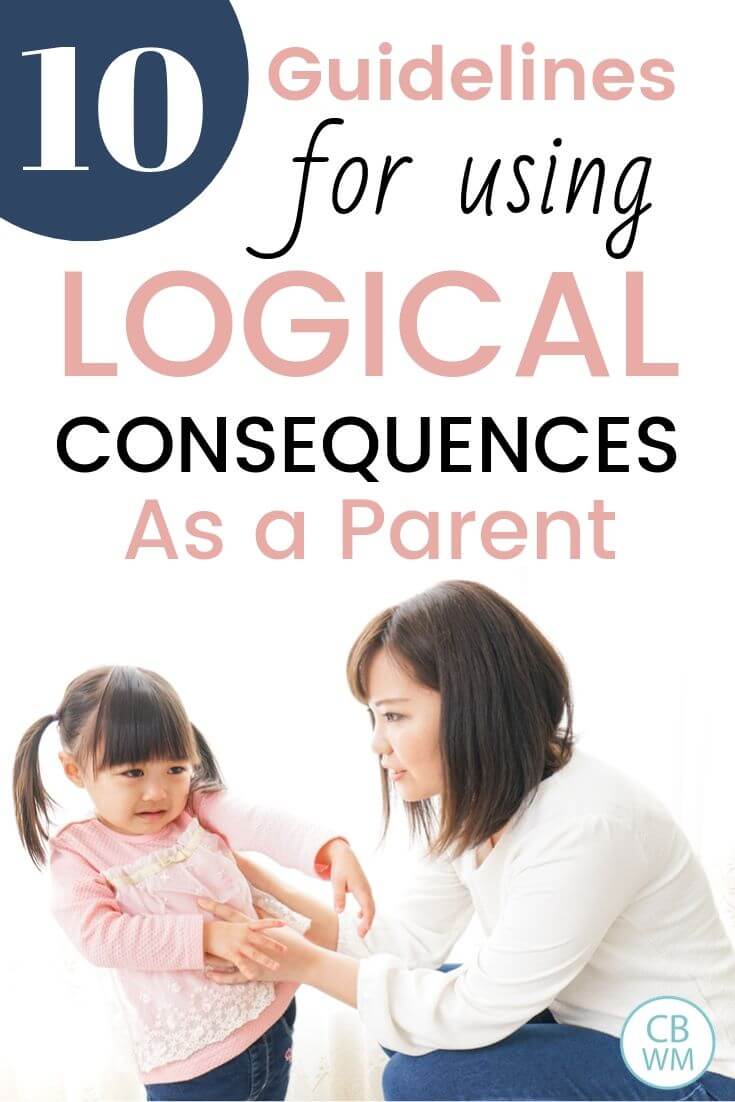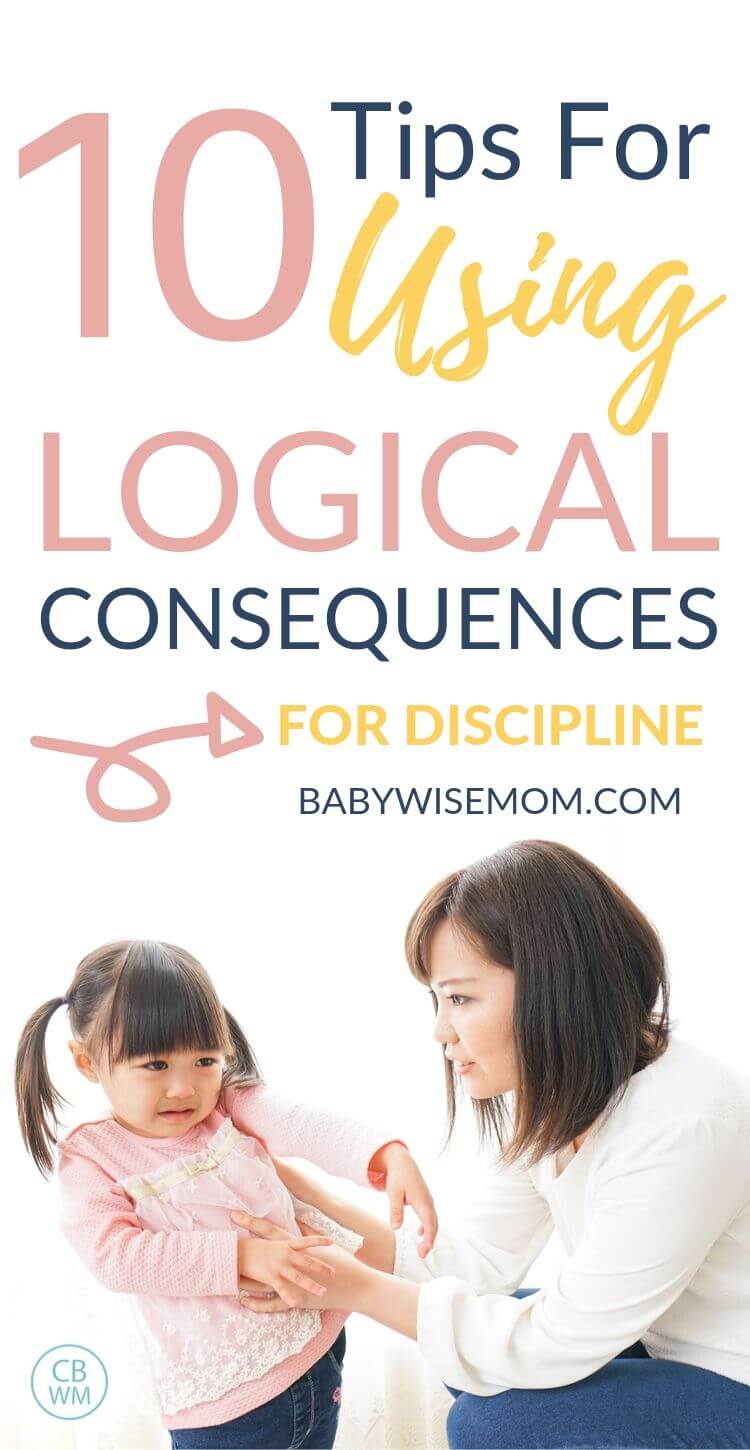Use these ten tips to successfully use logical consequences with your children. Logical consequences help kids learn that actions have consequences.

I have always found logical consequences to be very effective as a discipline tool. Logical consequences really allow a child to see that actions have consequences.
Newton stated that “for every action, there is an equal and opposite reaction.” This was in relation to objects, but it can easily be applied to our daily lives. What you do matters, and for better or worse, there will be a reaction. This is a fundamental truth to life and we do our children a favor by helping them learn that truth before they are adults.
Allowing consequences to run their course is a wise parenting decision. Easy? No way. But it is worth it.
There are different types of consequences. We have natural and logical. There is often a fuzzy line between the two. Read up on natural vs. logical consequences here.

Post Contents
Guidelines for Using Logical Consequences
Here are some of my personal guidelines when applying logical consequences. Here are my top ten tips for applying logical consequences to my children. Allowing consequences can seem harsh at times, but you are doing so to teach your child. These guidelines help you accomplish that teaching.
Be Consistent
This is the most common piece of parenting advice, isn’t it!?!?! Be consistent.
You need to be consistent with your logical consequences. This doesn’t mean that the same consequence must follow the same action, but it means a consequence must always follow a certain action.
You don’t sometimes apply a consequence for not picking up the toys when asked and other times let it slide. That is not fair to your child. How is he supposed to learn that way?
Consistency is the way he will learn the rules you are trying to put in place.
Write Your Rules
It might help you to write down your general rules so you have thought about it. If you write down your expectations, you know better what you expect and what you are working toward.
Here are some sample rules: Speak respectfully. Complete tasks when asked. Stay in bed until told to get out. Do your chores. Do not hit.
Write down your rules.
Some rules will change as your child gets older. One example is staying in bed. As your child gets older, he will be able to handle the freedom stay in bed until a certain time and then get up on his own.
You can use your Lifetime Goals as a guide in what rules might be good to set.
Once you have your rules written down, you will be better prepared to recognize, “Oh! This is an action that is against our rules and I must now do something about it.”
Write Your Routine
A lot of disobedience seems to correlate with your daily routine. Transitions can be hard for children. There might be fits or refusal to comply with coming inside, picking up toys, or going to nap. Writing your routine can help you think about and anticipate possible points of conflict in the day and prepare for them.
Having a solid routine will help your child not have as many fits. If you follow the same flow each day, your child will know that every day after independent play, you clean up the toys. No fit will change that. He knows that after lunch, you watch a show for 30 minutes and then go to nap. A fit won’t change that. Having a routine means you need to use consequences less because there are fewer fits.
Write Some Consequences
Next, write some consequences that might make sense for the breaking of a rule. What might be good for talking back? What might you do if your 18 month old refuses to come out of the sandbox? Think through and write down some good consequences you can turn to for common issues you do face or might face.
It is much easier to have consequences when you have a plan, especially if you have a hard time thinking on the fly or if you get flustered or emotional when your child disobeys.
For help thinking of things, read start with the post: Logical Consequences: What Was Misused?

Allow For Context
We are humans. This means we have the privilege of being able to apply mercy to our thinking and not just judgment.
Daily life with children is not a simple black and white algebra equation. It is kind of more like the abstract math equations that my husband encountered while working on his masters in engineering…equations I won’t pretend to have a grasp on. We must take into account the context of the situation.
Maybe you have decided that screaming at you or whining and crying earns some time in isolation. Your little 20 month old stomps in anger and does just that after you tell her to do clean up her toys.
You know she is tired (you had her up late last night) and she is a little late for lunch. In this situation, I wouldn’t go put her in isolation. I would give her a hug if she were amiable to it. I would say, “Sweetie, I know you are hungry and that you are tired, but that doesn’t mean you can talk mean to Mommy. It is not okay to talk to Mommy that way. You need to talk nice and you need to be obedient.”
I would then put her at the table and get her going on lunch immediately. If lunch wasn’t quite ready, I would give her some fruit and/or veggies until lunch was ready. After lunch, I would either put her down for her nap or have her clean up her toys if she were in a better mood. If she went straight to nap, I would have her clean up her toys after nap.
In this situation, you are making sure your child’s disobedience and screaming doesn’t get her out of doing what she has been asked, but you also recognize that there is a good chance she is behaving that way because of her hunger and sleepiness…and she is only 20 months old and absolutely hasn’t mastered the art of being nice even when hungry and tired.
You apply mercy in that the tantrum doesn’t warrant a consequence. But you don’t reward the fit either.
Read: Natural Consequences vs Grace
Give Warning
Take time in times of non-conflict to tell your child that from now on, consequences will follow breaking rules. If your child is a baby or young toddler, you can work consequences in as appropriate. It will just be a natural part of your lives.
If your child is a preschooler or older (and possibly older toddler), it is good to sit him down and explain that things will be different. Don’t expect a big hug and thank you, but it is fair to give warning before changing the rules.
Take Time To Think When Needed
It is okay to take time to think about a consequence. You don’t always have to apply the consequence immediately with preschool age and up. You can say, “I am going to take some time to think about an appropriate consequence for that action.”
Sometimes, the anticipation waiting for the consequence is more punishment than the punishment itself.
Remain Calm
Always remain calm while applying your consequences. Don’t scream and yell. Talk in the same voice you would when talking about the weather. Stay calm and matter-of-fact. When you lose your cool, it is easy for your child to place frustration at the consequence on you. Your child can easily get upset toward you and make you the bad-guy instead of realizing the consequences is a direct result of her own action.
Show Empathy
Tell your child you are sorry he made that choice. When he is sad that he lost his toys, empathize with him, “I know. That is sad to lose your toys. I didn’t want you to lose your toys, either.”
Just as remaining calm helps your child not put blame on you, empathy helps show your child to not be angry at you and also helps them know you love them even though they messed up. This is an invaluable truth to establish before your children hit teenage years. They need to be able to come to you when they mess up.
Keep Responsibility On the Child
Say things like, “Oh, I am sorry you decided to not pick up your toys when I asked. Now I have to take them away.” Make it clear that the consequence is happening because of your child’s actions, not because you are mad or mean. This is why remaining calm and showing empathy are helpful.
Conclusion
Allowing consequences to happen or enforcing consequences for poor choices is an excellent way for your child to learn what is okay and what is not okay. These ten guidelines will help you use consequences in a way that teaches your child and keeps you both on the same team.
RELATED POSTS
- The Benefits of Teaching Consequences
- Making Sure Consequences Actually Work for Kids
- Discipline 101: The Basics for Correcting Children
